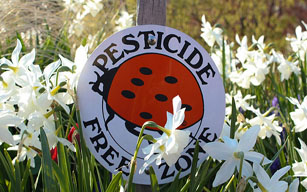 The Westchester County Pesticide Reduction Law, Chapter 690 of the Laws of Westchester, was originally passed in 1996 and amended in Oct. 2000. The following is an overview of the provisions of the Law that control pesticide applications.
The Westchester County Pesticide Reduction Law, Chapter 690 of the Laws of Westchester, was originally passed in 1996 and amended in Oct. 2000. The following is an overview of the provisions of the Law that control pesticide applications.
The Oct. 2000 amendments phased out the use of all pesticides on Westchester County properties. The phase out provisions are frequently referred to as the “Sunset Provisions” and may be found in Section 690.05 of the Law.
Unless an Exception to the Law is granted under Section 690.07, effective as of the date of passage, application of a United States Environmental Protection Agency (USEPA) Toxicity Category I pesticide is prohibited. Also effective as of the date of passage, application of any pesticide classified by the EPA as a known, likely, or possible carcinogen is prohibited.
Effective January 1, 2001 application of a USEPA Toxicity Category II pesticide is prohibited. Also, application of any pesticide classified by the USEPA or the New York State Department of Environmental Conservation (DEC) as a restricted use pesticide is prohibited. Again, subject to the Exceptions available under Section 690.07 of the Law.
Effective January 1, 2002 application of a USEPA Toxicity Category III pesticide is prohibited.
Exemptions to the Sunset Provisions
Certain pesticides are exempted from the Sunset Provisions. Such pesticides include pesticides lawfully used to maintain a safe drinking water supply, anti-microbial pesticides, microbial pesticides such as Bacillus thuringiensis (Bt) and milky spore, pesticides in contained baits, low-toxicity pesticides such as boric acid, silica gels and diatomaceous earth and pesticides prescribed by a licensed veterinarian for control of parasites.
Exemptions also apply to pesticides used in the event the New York State or County Commissioner of Health declares a public health emergency.
The Pest Management Committee may grant an exception to the Law’s Sunset Provisions upon written application by a county board, department, contractor or employee. In order for the Pest Management Committee to grant a waiver of the Sunset Provisions, the following conditions must be met:
- The pest situation poses an immediate threat to public resources
- Viable alternatives do not exist
After consultation with an expert in the Integrated Pest Management field, the Pest Management Committee determines the least toxic approach to resolving the situation and directs that the waiver be restricted to the use of the least toxic approach. The applicant for the waiver must provide a written plan to prevent future outbreaks.
It is important to note that a waiver granted by the Pest Management Committee is for a single application of a pesticide otherwise prohibited under the Law’s Sunset Provisions.